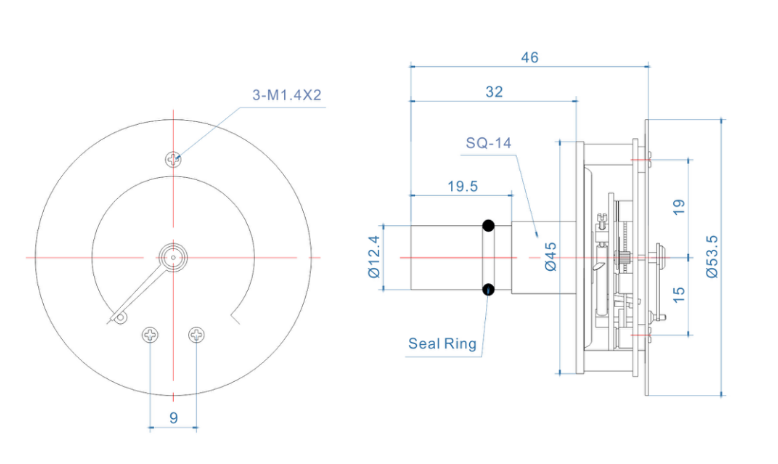
Out . 17, 2024 03:55 Back to list
Overview of Diaphragm Pressure Gauge Features and Applications
Understanding Diaphragm Pressure Gauge Products
In various industrial applications, accurate pressure measurement is crucial for ensuring operational efficiency, safety, and equipment reliability. Among the various instruments used to measure pressure, diaphragm pressure gauges stand out for their accuracy and robustness. This article will explore diaphragm pressure gauge products, their construction, working principle, advantages, applications, and considerations when selecting one for your needs.
What is a Diaphragm Pressure Gauge?
A diaphragm pressure gauge is a type of pressure sensor that uses a flexible diaphragm to measure pressure in gases or liquids. The diaphragm flexes in response to pressure changes, translating mechanical movement into an easily readable output on a dial or digital display. These gauges can be constructed from various materials, such as stainless steel, plastic, or specialized alloys, depending on the application and environment.
Construction and Working Principle
The basic construction of a diaphragm pressure gauge includes the following components
1. Diaphragm A thin, flexible membrane that reacts to pressure changes. When pressure is applied, the diaphragm moves, causing the connected mechanism to indicate the pressure level. 2. Bourdon Tube (optional) In some designs, a Bourdon tube may also be used in conjunction with the diaphragm to enhance the gauge's sensitivity and range.
3. Spring Mechanism Springs are often employed to provide a consistent return force, allowing for accurate readings and compensating for slight shifts in pressure.
4. Indicator A needle or digital readout that displays the measured pressure.
The working principle is relatively simple As the pressure in the system increases, it pushes against the diaphragm, causing it to deform. This deformation is then translated into a mechanical movement that moves the needle on the gauge or triggers a digital sensor, ultimately giving a pressure reading.
Advantages of Diaphragm Pressure Gauges
Diaphragm pressure gauges offer several advantages
- High Accuracy They can provide precise measurements even at low pressures, which is essential in many applications.
- Durability With rugged construction, diaphragm gauges can handle harsh environments, including corrosive media and high vibrations.
- Versatility They can measure a wide range of pressures, making them suitable for various industries, including oil and gas, food and beverage, and pharmaceuticals.
explain diaphragm pressure gauge products

- Compact Design Their design makes them suitable for installation in tight spaces where traditional gauges may not fit
.- Low Maintenance Once correctly installed, diaphragm pressure gauges require minimal maintenance, resulting in lower operational costs.
Applications
Diaphragm pressure gauges are employed in numerous applications, including
- Oil and Gas Monitoring pressure in pipelines and tanks. - Water Treatment Measuring pressure in pumps and filtration systems. - Manufacturing Ensuring the pressure in hydraulic systems is within safe limits. - Pharmaceuticals Maintaining the integrity of sterile processes through accurate pressure measurement.
Considerations for Selection
When selecting a diaphragm pressure gauge, several factors must be considered
1. Pressure Range Determine the expected pressure range of your application to ensure that the gauge can handle it without damage.
2. Media Compatibility Ensure that the diaphragm material is compatible with the media being measured. For corrosive liquids, a suitable material (such as stainless steel) must be chosen.
3. Accuracy Requirements Different applications may require different levels of accuracy; choose a gauge that meets these needs.
4. Connection Size and Type Ensure that the gauge can be easily integrated into your existing system, paying attention to the connection size and type.
5. Environmental Conditions Consider factors such as temperature, humidity, and potential exposure to chemicals that could affect the gauge's performance.
Conclusion
Diaphragm pressure gauges are essential instruments in various industries, providing accurate and reliable pressure measurements across diverse applications. Their construction, working principle, and versatility make them suitable for many environments. By understanding the key features and considerations when selecting a diaphragm pressure gauge, you can ensure that you choose the right product for your specific needs, ultimately enhancing safety and efficiency in your operations.
-
High-Precision 5 Valve Manifold Differential Pressure Gauge Suppliers
NewsApr.29,2025
-
High-Precision Diaphragm Vacuum Pressure Gauges Manufacturers & Quotes
NewsApr.29,2025
-
Omega Differential Pressure Gauges High Accuracy & Durability
NewsApr.28,2025
-
Low Pressure Differential Pressure Gauges Precision Solutions & Quotes
NewsApr.28,2025
-
Digital Diaphragm Pressure Gaauge Precision Measurement & OEM Quotes
NewsApr.28,2025
-
Differential Pressure Gauge China Price High-Accuracy & Best Quotes
NewsApr.28,2025
